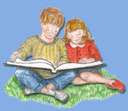
1.
Bibliography: Prelutsky, Jack. 2000.
It's Raining Pigs & Noodles. New York: Scholastic, Inc. ISBN 0-439-32929-9.
2.
Plot Summary:
It's Raining Pigs & Noodles is a collection of short, energetic poems written for the young and the young at heart. Readers will enjoy the diversity of these poems ranging from ridiculous to disgusting to just plain funny.
3. Critical Analysis: With effervescent humor, Jack Prelutsky has compiled another collection of poems sure to appeal to both children and adults. Over 100 poems illustrated with black and white sketch drawings by James Stevenson, provide visual satisfaction while maintaining the ultimate focus on the poetry. Word arrangements of poems like "I'm Caught Up in Infinity" (written in an horizontal figure eight), "Zigzag" and "I Am Winding Through a Maze" (both written to illustrate their titles), stimulate the eyes and mind and make reading these poems fun. The upbeat rhythm and simple rhyming language of words such as machine/clean, flat/cat in "I Build a Fabulous Machine" and relax/tracks, why/by in "It Is Foolish to Relax", make this a great introduction to poetry for young readers or as a read aloud. Children will also find entertaining the imagery fashioned by fictitious creatures and nonsensical words in poems such as "Dear Wumbledeedumble" ("the wings on the side of your head, your feathery chest and your leathery crest"), and will delight in appealingly gross poems like "My Tongue is Tasting Terrible ("all I ate was pickled snake, and chicken beaks on rye") and "Worm Puree" ("Worm puree, pink and gray, you're a heavenly entree."). Time and again, Prelutsky appeals to the senses of the child, as well as to the child in the grown-up. Kids will delight in It's Raining Pigs & Noodles and relish in the laughter it is sure to provoke, enticing the reader into a page-turning, poem-reading frenzy!
4. Review Excerpts:
- Horn Book: Prelutsky plays his way through silly images, nonsense words, and corny punch lines. Some of the 106 poems celebrate childhood mischief; and it wouldn't be Prelutsky without a bit of the gross. As in their previous books, Stevenson deftly follows the goofy tone in small homely pen sketches sprinkled among the verse. Some of the jokes will be best understood by adults, but the book is sure to tickle readers young and old.
- The Lorgnette - Heart of Texas Reviews: Children of all ages enjoy the poetry and word play of Jack Prelutsky. His books are always fun and full of things that childhood memories are made of. This one is no exception and is a must have book.
5. Connections:
- Read other collections of poems by Jack Prelutsky. Discuss what is similar and different in the style, language, and content.
- Use individual poems as prompts for student written poetry. For example, read "Today Was Not My Day at All", then have students add to the poem with other mishaps of the day.
- As a class, create an imaginary creature with a nonsensical name, then have students work with a partner to write a poem describing its features and behaviors. Share with the class.







